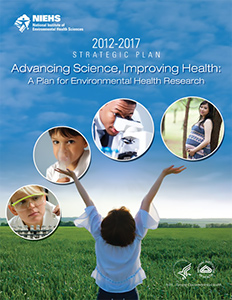
As we near the end of our current Strategic Plan 2012–2017—Advancing Science, Improving Health: A Plan for Environmental Health Research NIEHS is currently examining our success in implementing the plan’s goals.
As a next step, we are also re-examining these goals in light of scientific progress and advances made, trends in issues and approaches, and opportunities to explore new or additional priorities, as we look to update the plan to guide the next 5-year phase of the Institute’s work.
NIEHS Strategic Plan 2012-2017 Goals
NIEHS, with the help of our stakeholders, has identified themes and goals:
- Goal 1: Identify and understand fundamental shared mechanisms or common biological pathways, e.g., inflammation, epigenetic changes, oxidative stress, mutagenesis, etc., underlying a broad range of complex diseases, in order to enable the development of applicable prevention and intervention strategies.
- Goal 2: Understand individual susceptibility across the life span to chronic, complex diseases resulting from environmental factors, in basic and population-based studies, to facilitate prevention and decrease public health burden.
- Goal 3: Transform exposure science by enabling consideration of the totality of human exposures and links to biological pathways, and create a blueprint for incorporating exposure science into human health studies.
- Goal 4: Understand how combined environmental exposures affect disease pathogenesis.
- Goal 5: Identify and respond to emerging environmental threats to human health, on both a local and global scale.
- Goal 6: Establish an environmental health disparities research agenda to understand the disproportionate risks of disease, and to define and support public health and prevention solutions in affected populations.
- Goal 7: Use knowledge management techniques to create a collaborative environment for the environmental health sciences (EHS) community, to encourage an interdisciplinary approach to investigate, analyze, and disseminate findings.
- Goal 8: Enhance the teaching of EHS at all levels of education and training — kindergarten through professional — to increase scientific literacy and generate awareness of the health consequences of environmental exposures.
- Goal 9: Inspire a diverse and well-trained cadre of scientists to move our transformative environmental health science forward, and train the next generation of EHS leaders from a wider range of scientific disciplines and diverse backgrounds.
- Goal 10: Evaluate the economic impact of policies, practices, and behaviors that reduce exposure to environmental toxicants, through prevention of disease and disabilities, and invest in research programs to test how prevention improves public health and minimizes economic burden.
- Goal 11: Promote bidirectional communication and collaboration between researchers and stakeholders, e.g., policy-makers, clinicians, intervention and prevention practitioners, and the public, in order to advance research translation in the environmental health sciences.


